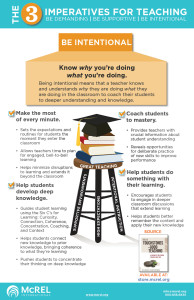
Don’t get mad, get ready! While we could do without the eye-rolling that frequently accompanies this inquiry, the question itself is perfectly valid. We should ask ourselves before every lesson, Why do my students have to know this? Finding the answer is part of being intentional with one’s instruction—and it’s one of three key imperatives for effective teaching, along with being demanding and being supportive, that are discussed in McREL’s The 12 Touchstones of Good Teaching.
Being intentional means that teachers know and understand why they are doing what they are doing in the classroom to coach their students to deeper understanding and knowledge.
There are four key things for teachers to think about within the be intentional imperative. It’s good to reflect on these throughout the school year, and self-assess how you’re doing:
1. Make the most of every minute.
2. Help students develop deep knowledge.
3. Coach students to mastery.
4. Help students do something with their learning.
Teachers need to make the most of every minute by ensuring that instruction starts when class starts and doesn’t end until the bell rings. A few minutes lost at the beginning and end of class may not seem like a concern, but add up the minutes and it equals hours of lost instructional time over the course of a school year. A great and ambitious goal for teachers is to plan their lessons for bell-to-bell learning. There are a number of ways to help achieve this goal:
- Set expectations and routines for what the students should immediately do when they enter your classroom.
- Have students place homework in a homework basket instead of passing it forward once they are seated.
- Post a problem, picture, or question on the board for students to immediately start working on at the beginning of class.
- Create a seating chart, which you change periodically, to aid in taking attendance.
- Ask questions about current events as students are packing up their belongings at the end of class.
Teachers are a key ingredient to helping students develop deep knowledge about the content, instead of simply memorizing what they need to know for the test or class. Teachers can help students make connections and see patterns with their learning. There must be true understanding of the content for the students to apply their learning to other contexts, as well. The 12 Touchstones provides Six Essential Cs for Learning:
- Curiosity: Search for ways to develop interest by finding a “hook” to get students curious. Provide a couple of clues and have students ask questions to determine the correct answer.
- Connection: Help students recall their background knowledge and show them how it connects to their new knowledge. Give explicit cues that will help them activate their background knowledge.
- Coherence: Show students the big picture and help them find the connections and patterns in the details. Display nonlinguistic representations to help students recall information.
- Concentration: Provide adequate time for students to think about what you have taught them. Ask high-level questions that will engage them in deep thinking.
- Coaching: Coach students to a higher level of learning by providing guided practice and descriptive and specific feedback that helps them learn and grow.
- Context: Provide opportunities for students to make the connection between their learning and real-world context. Give the students opportunities to apply and repeat procedures to improve their long-term memory.
Teachers help coach students to mastery by conducting frequent checks on understanding, providing specific feedback, and identifying areas for improvement to help students master the content. If teachers plow through the material without knowing whether students understand it, they’re missing out on opportunities to provide support for student learning. A teacher might need to reteach content to ensure students understand it. Here are some ways to check for understanding:
- Have students give a thumbs-up, thumbs-sideways, or thumbs-down when you check for understanding. When a safe and respectful classroom environment has been established, students should feel comfortable self-assessing, even when they offer a thumbs-down.
- Students can turn and talk with their peers to summarize the learning that is taking place. By explaining their learning to their peers, they gain a deeper knowledge of the content.
- Use a poll app (e.g., Poll Everywhere, Kahoot!) to collect data and determine the level of student understanding.
- Have students complete an exit ticket at the end of class by summarizing their learning. This will help you determine if you need to reteach anything the next time you are together.
Teachers help students do something with their learning by connecting the new knowledge to real-world settings. Making the connections and showing how the learning can be applied will help students remember the content. When students understand the why, it will lead to deeper thinking and learning. Projects are a great way for students to apply their knowledge. However, make sure you know why you are having them do the project. Without a research-based rationale, the project might just be busy-work that has no intrinsic value nor extension of learning. Here are some examples on how to help students do something with their learning:
- Find an expert who is willing to come in or Skype with your class to provide additional information and answer questions. (See a great example.)
- Interview people, such as veterans or retired community members, to learn about their experiences and provide context on what the students are studying and how it relates. Speaking with people about a specific topic will help students make connections to the real world.
- Ask tough questions to get your students respectfully discussing and debating at a deeper level.
- Have students complete short writing assignments that make them think and reflect rather than regurgitate what you have taught them.
As you plan your next lesson, make sure to pause and ask yourself why you’re doing what you’re doing and what you want students to do with the knowledge. Use the comment section below to share your ideas, questions, and comments about how you are being intentional with your instruction.
In this 3-part blog post series, I’ve addressed each of the three imperatives presented in The 12 Touchstones of Good Teaching: A Checklist for Staying Focused Every Day.
Read my post on how to be demanding.
Read my post on how to be supportive.

Even the most dedicated and experienced teachers can benefit from having a strategic checklist to boost their effectiveness. What are the 12 simple but essential things you can do every day to deliver high-quality instruction and positively impact student outcomes? Bryan Goodwin and Elizabeth Hubbell reviewed thousands of research studies, books, and articles to supply the answer in The 12 Touchstones of Good Teaching: A Checklist for Staying Focused Every Day. In addition to identifying the 12 touchstones, the authors also define three key imperatives for quality teaching and learning—be demanding, be supportive, and be intentional—and offer strategies for integrating them into classroom practice. Order The 12 Touchstones of Good Teaching from the McREL Bookstore. Learn more.


Wow, building a lesson plan that truly includes every classroom moment…make the most of every minute (bell-to-bell). Not a different paradigm of instruction, just a different way of looking at it and obtaining true ownership of said time. A time of excellence and execution of the mission at hand. Love it!
This was a awesome article. Demanding the best from students help students believe they can achieve. I believe demanding brings academic success and students have respect for teachers
Projects are an excellent way to check for understanding. Connecting to real-world settings tends to “stick” with students and enhances their learning. The platform can be added to as students learn more and become more curious.